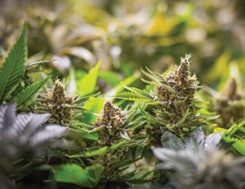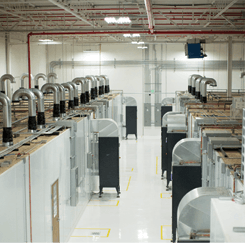

Even in Colorado’s ideal climate for cultivating marijuana, growers like Denver-based Medicine Man are carefully juggling electricity and money to control humidity. Smart climate control is a business imperative in an environment where cannabis prices are dropping, but labor and energy costs continue to rise.

Medicine Man Director of Operations Tyler Schneider is managing a full power upgrade on a portion of the company’s 40,000-square-foot facility, where approximately 500 cannabis plants are harvested each week. “Once the upgrade is done, we’re installing 17 brand-new dehumidifiers,” he says.
Schneider is a former HVAC engineer who brought 20 years of experience with him when he joined Medicine Man.
“The mentality most people have about everything from cars to air conditioning is to wait for things to break,” he says. “People think, ‘If it’s not broke, why fix it?’” Schneider quickly established a quarterly preventative-maintenance program, supported by a maintenance crew of four people. “We do maintenance for a reason,” he says. “We don’t want failures.”
It’s all part of Medicine Man’s strategy to maintain strict parameters for humidity levels and room temperature.
In addition to maintaining temperature and humidity, the company minimizes the risk of spreading mildew or pests by organizing crops in 14 isolated pods. “If we ever lost a crop, it would hopefully be a very small portion of our grow,” he says.

Each pod has sensors that monitor and record temperature, humidity and CO2 data 24 hours a day, seven days a week. “If you do nothing about the radiant heat generated by [all] those bulbs, your room would get up to 120 degrees pretty fast, and you would pretty much fry your plants,” says Schneider.
In a single pod, each of the 500 plants gets a gallon of water every other day. It’s inevitable for some moisture to evaporate into the room's air and raise humidity. In fact, humidity can reach 80 percent with watering and preventative spraying for mildew, mold and insects, Schneider says. “Without proper air conditioning and supplemental dehumidification, buds can rot from the inside out, and you can’t even tell it’s happening until it’s too late,” he says.
Medicine Man’s automated systems restore everything to an ideal range within 45 minutes of a spike.
During his tenure, Schneider says he has only seen four plants with bud rot, a sign that their methods are working. Here are four humidity-control tips gleaned from his experience at Medicine Man.

1. Promote good airflow. Medicine Man spreads plants to keep them from touching each other. Their layout may sacrifice a certain amount of yield, but losing a crop due to bud rot or other moisture-driven diseases could easily defeat the purpose of a dense plant population.
2. Use data loggers to record humidity and temperature at all times. Growers can collect data and use it to make good decisions. “If you consistently see 60-percent humidity or higher, you may need to invest in dehumidification,” he says.
3. Don’t use all your power on lights. “A lot of problems in big facilities are caused by using all the available power on lights,” says Schneider. “They don’t have enough power left to install dehumidifiers.”
When growers get greedy with lights, they can overload circuits, trip breakers, receive fines from fire departments and neglect their air conditioning and dehumidification requirements. The desire to increase yield with more plants and more lights may ultimately jeopardize an entire crop.
4. Plan and build a well-designed facility. “We learned from the school of hard knocks and replaced a lot of equipment because there was no one to follow when we started,” he says. “If someone is looking at opening a new grow, I would recommend that they plan it right. Do it once.”


















